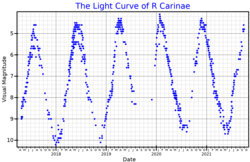| Observation data Epoch J2000.0 Equinox J2000.0 | |
|---|---|
| Constellation | Carina |
| Right ascension | 09h 32m 14.59964s[2] |
| Declination | −62° 47′ 20.0452″[2] |
| Apparent magnitude (V) | 3.9 - 10.5[3] |
| Characteristics | |
| Evolutionary stage | AGB[4] |
| Spectral type | M6/7pe[5] |
| B−V color index | 0.906±0.009[6] |
| Variable type | Mira[3] |
| Astrometry | |
| Radial velocity (Rv) | +28.1±1.0[6] km/s |
| Proper motion (μ) | RA: −37.900[2] mas/yr Dec.: +22.232[2] mas/yr |
| Parallax (π) | 2.5813 ± 0.4460 mas[2] |
| Distance | approx. 1,300 ly (approx. 390 pc) |
| Absolute magnitude (MV) | 1.48[6] (at mv = 7.43) |
| Details | |
| Mass | 0.87+0.47 −0.31[4] M☉ |
| Radius | 241.0+37.6 −32.6[4] R☉ |
| Luminosity | 4,571+1,331 −1,031[4] L☉ |
| Temperature | 2,800[7] K |
| Other designations | |
| Database references | |
| SIMBAD | data |
R Carinae is a double star in the southern constellation of Carina. The brighter component is a variable star that can be viewed with the naked eye at peak brightness,[9] but is usually too faint to be seen without a telescope, having an apparent visual magnitude that fluctuates around 7.43.[6] This star is located at a distance of approximately 1,300 light years from the Sun based on parallax, and is drifting further away with a radial velocity of +28 km/s.[6]
The main component is an aging red giant star on the asymptotic giant branch[4] with a stellar classification of M6/7pe.[5] It is classified as a pulsating Mira type variable star and its visual brightness varies with an average amplitude of 4.25 magnitudes over a period of 303.99±1.08 d. Its average maximum visual magnitude is 5.05±0.45,[9] but the brightest observed maximum was magnitude 3.9[3] This star is surrounded by a dusty shell, with properties that are consistent with iron-poor silicates or corundum, extending from around three stellar radii outward.[10]
The companion is a magnitude 11.30 star at an angular separation of 2.10″ along a position angle of 132° from the main star, as of 2015.[11]
References
[edit]- ^ "Download Data". aavso.org. AAVSO. Retrieved 1 October 2021.
- ^ a b c d e Brown, A. G. A.; et al. (Gaia collaboration) (August 2018). "Gaia Data Release 2: Summary of the contents and survey properties". Astronomy & Astrophysics. 616. A1. arXiv:1804.09365. Bibcode:2018A&A...616A...1G. doi:10.1051/0004-6361/201833051. Gaia DR2 record for this source at VizieR.
- ^ a b c Samus, N. N.; et al. (2017), "General Catalogue of Variable Stars", Astronomy Reports, 5.1, 61 (1): 80–88, Bibcode:2017ARep...61...80S, doi:10.1134/S1063772917010085, S2CID 125853869.
- ^ a b c d e Takeuti, Mine; et al. (2013), "A Method to Estimate the Masses of Asymptotic Giant Branch Variable Stars", Publications of the Astronomical Society of Japan, 65 (3): 60, Bibcode:2013PASJ...65...60T, doi:10.1093/pasj/65.3.60.
- ^ a b Houk, Nancy; Cowley, A. P. (1979), Michigan catalogue of two-dimensional spectral types for the HD stars, vol. 1, Ann Arbor, Michigan: Dept. of Astronomy, University of Michigan, Bibcode:1978mcts.book.....H.
- ^ a b c d e Anderson, E.; Francis, Ch. (2012), "XHIP: An extended hipparcos compilation", Astronomy Letters, 38 (5): 331, arXiv:1108.4971, Bibcode:2012AstL...38..331A, doi:10.1134/S1063773712050015, S2CID 119257644.
- ^ McDonald, I.; Zijlstra, A. A.; Boyer, M. L. (2012), "Fundamental parameters and infrared excesses of Hipparcos stars", Monthly Notices of the Royal Astronomical Society, 427 (1): 343, arXiv:1208.2037, Bibcode:2012MNRAS.427..343M, doi:10.1111/j.1365-2966.2012.21873.x, S2CID 118665352.
- ^ "R Car". SIMBAD. Centre de données astronomiques de Strasbourg. Retrieved 2020-01-30.
- ^ a b Vogt, N.; et al. (2016), "Determination of Pulsation Periods and Other Parameters of 2875 Stars Classified As Mira in the All Sky Automated Survey (Asas)", The Astrophysical Journal Supplement Series, 227 (1): 6, arXiv:1609.05246, Bibcode:2016ApJS..227....6V, doi:10.3847/0067-0049/227/1/6, S2CID 119295645.
- ^ Ireland, M. J.; et al. (July 2005), "Dust scattering in the Miras R Car and RR Sco resolved by optical interferometric polarimetry", Monthly Notices of the Royal Astronomical Society, 361 (1): 337–344, arXiv:astro-ph/0505112, Bibcode:2005MNRAS.361..337I, doi:10.1111/j.1365-2966.2005.09181.x, S2CID 14724805.
- ^ Mason, B. D.; et al. (2014), "The Washington Visual Double Star Catalog", The Astronomical Journal, 122 (6): 3466, Bibcode:2001AJ....122.3466M, doi:10.1086/323920.

Well, that’s interesting to know that Psilotum nudum are known as whisk ferns. Psilotum nudum is the commoner species of the two. While the P. flaccidum is a rare species and is found in the tropical islands. Both the species are usually epiphytic in habit and grow upon tree ferns. These species may also be terrestrial and grow in humus or in the crevices of the rocks.
View the detailed Guide of Psilotum nudum: Detailed Study Of Psilotum Nudum (Whisk Fern), Classification, Anatomy, Reproduction